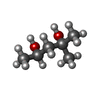[English] 日本語
 Yorodumi
Yorodumi- PDB-4en6: Crystal structure of HA70 (HA3) subcomponent of Clostridium botul... -
+ Open data
Open data
- Basic information
Basic information
| Entry | Database: PDB / ID: 4en6 | |||||||||
|---|---|---|---|---|---|---|---|---|---|---|
| Title | Crystal structure of HA70 (HA3) subcomponent of Clostridium botulinum type C progenitor toxin in complex with alpha 2-3-sialyllactose | |||||||||
 Components Components | (Hemagglutinin components HA-22/23/53) x 2 | |||||||||
 Keywords Keywords | SUGAR BINDING PROTEIN / Carbohydrate/Sugar Binding | |||||||||
| Function / homology |  Function and homology information Function and homology information | |||||||||
| Biological species |  | |||||||||
| Method |  X-RAY DIFFRACTION / X-RAY DIFFRACTION /  SYNCHROTRON / SYNCHROTRON /  MOLECULAR REPLACEMENT / Resolution: 2.56 Å MOLECULAR REPLACEMENT / Resolution: 2.56 Å | |||||||||
 Authors Authors | Yamashita, S. / Yoshida, H. / Tonozuka, T. / Nishikawa, A. / Kamitori, S. | |||||||||
 Citation Citation |  Journal: Febs Lett. / Year: 2012 Journal: Febs Lett. / Year: 2012Title: Carbohydrate recognition mechanism of HA70 from Clostridium botulinum deduced from X-ray structures in complexes with sialylated oligosaccharides Authors: Yamashita, S. / Yoshida, H. / Uchiyama, N. / Nakakita, Y. / Nakakita, S. / Tonozuka, T. / Oguma, K. / Nishikawa, A. / Kamitori, S. #1:  Journal: J.Mol.Biol. / Year: 2009 Journal: J.Mol.Biol. / Year: 2009Title: Crystal structure of the HA3 subcomponent of Clostridium botulinum type C progenitor toxin Authors: Nakamura, T. / Kotani, M. / Tonozuka, T. / Ide, A. / Oguma, K. / Nishikawa, A. | |||||||||
| History |
|
- Structure visualization
Structure visualization
| Structure viewer | Molecule:  Molmil Molmil Jmol/JSmol Jmol/JSmol |
|---|
- Downloads & links
Downloads & links
- Download
Download
| PDBx/mmCIF format |  4en6.cif.gz 4en6.cif.gz | 146.8 KB | Display |  PDBx/mmCIF format PDBx/mmCIF format |
|---|---|---|---|---|
| PDB format |  pdb4en6.ent.gz pdb4en6.ent.gz | 111.1 KB | Display |  PDB format PDB format |
| PDBx/mmJSON format |  4en6.json.gz 4en6.json.gz | Tree view |  PDBx/mmJSON format PDBx/mmJSON format | |
| Others |  Other downloads Other downloads |
-Validation report
| Arichive directory |  https://data.pdbj.org/pub/pdb/validation_reports/en/4en6 https://data.pdbj.org/pub/pdb/validation_reports/en/4en6 ftp://data.pdbj.org/pub/pdb/validation_reports/en/4en6 ftp://data.pdbj.org/pub/pdb/validation_reports/en/4en6 | HTTPS FTP |
|---|
-Related structure data
| Related structure data |  4en7C  4en8C 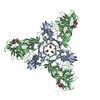 4en9C 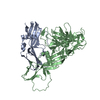 2zs6S S: Starting model for refinement C: citing same article ( |
|---|---|
| Similar structure data |
- Links
Links
- Assembly
Assembly
| Deposited unit | 
| ||||||||
|---|---|---|---|---|---|---|---|---|---|
| 1 | 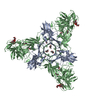
| ||||||||
| Unit cell |
|
- Components
Components
| #1: Protein | Mass: 26050.873 Da / Num. of mol.: 1 / Fragment: HA22-23(HA3a) Source method: isolated from a genetically manipulated source Source: (gene. exp.)   | ||
|---|---|---|---|
| #2: Protein | Mass: 47333.520 Da / Num. of mol.: 1 / Fragment: HA53(HA3b) Source method: isolated from a genetically manipulated source Source: (gene. exp.)   | ||
| #3: Polysaccharide | N-acetyl-alpha-neuraminic acid-(2-3)-beta-D-galactopyranose-(1-4)-beta-D-glucopyranose Source method: isolated from a genetically manipulated source | ||
| #4: Chemical | ChemComp-MRD / ( #5: Water | ChemComp-HOH / | |
-Experimental details
-Experiment
| Experiment | Method:  X-RAY DIFFRACTION / Number of used crystals: 1 X-RAY DIFFRACTION / Number of used crystals: 1 |
|---|
- Sample preparation
Sample preparation
| Crystal | Density Matthews: 4.9 Å3/Da / Density % sol: 74.89 % |
|---|---|
| Crystal grow | Temperature: 293 K / Method: vapor diffusion, hanging drop / pH: 4.6 Details: 12%(v/v) 2-methyl-2,4-pentendiol, 20mM CaCl2, 100mM sodium acetate, pH 4.6, VAPOR DIFFUSION, HANGING DROP, temperature 293K |
-Data collection
| Diffraction | Mean temperature: 100 K |
|---|---|
| Diffraction source | Source:  SYNCHROTRON / Site: SYNCHROTRON / Site:  SPring-8 SPring-8  / Beamline: BL26B1 / Wavelength: 1 Å / Beamline: BL26B1 / Wavelength: 1 Å |
| Detector | Type: RIGAKU SATURN A200 / Detector: CCD / Date: Jul 15, 2010 |
| Radiation | Protocol: SINGLE WAVELENGTH / Monochromatic (M) / Laue (L): M / Scattering type: x-ray |
| Radiation wavelength | Wavelength: 1 Å / Relative weight: 1 |
| Reflection | Resolution: 2.56→50 Å / Num. all: 45881 / Num. obs: 45881 / % possible obs: 99.8 % / Observed criterion σ(F): 0 / Observed criterion σ(I): 0 / Redundancy: 5.8 % / Biso Wilson estimate: 49.4 Å2 / Rmerge(I) obs: 0.088 / Net I/σ(I): 13.7 |
| Reflection shell | Resolution: 2.56→2.6 Å / Redundancy: 5.7 % / Rmerge(I) obs: 0.399 / Mean I/σ(I) obs: 3.8 / Num. unique all: 2308 / % possible all: 100 |
- Processing
Processing
| Software |
| |||||||||||||||||||||||||
|---|---|---|---|---|---|---|---|---|---|---|---|---|---|---|---|---|---|---|---|---|---|---|---|---|---|---|
| Refinement | Method to determine structure:  MOLECULAR REPLACEMENT MOLECULAR REPLACEMENTStarting model: PDB ENTRY 2ZS6 Resolution: 2.56→25.74 Å / Rfactor Rfree error: 0.003 / Data cutoff high absF: 111550.21 / Data cutoff low absF: 0 / Isotropic thermal model: RESTRAINED / Cross valid method: THROUGHOUT / σ(F): 0 / σ(I): 0 / Stereochemistry target values: Engh & Huber
| |||||||||||||||||||||||||
| Solvent computation | Solvent model: FLAT MODEL / Bsol: 48.64 Å2 / ksol: 0.32441 e/Å3 | |||||||||||||||||||||||||
| Displacement parameters | Biso mean: 52.8 Å2
| |||||||||||||||||||||||||
| Refine analyze |
| |||||||||||||||||||||||||
| Refinement step | Cycle: LAST / Resolution: 2.56→25.74 Å
| |||||||||||||||||||||||||
| Refine LS restraints |
| |||||||||||||||||||||||||
| LS refinement shell | Resolution: 2.56→2.72 Å / Rfactor Rfree error: 0.011 / Total num. of bins used: 6
| |||||||||||||||||||||||||
| Xplor file |
|
 Movie
Movie Controller
Controller



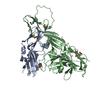
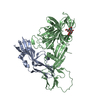

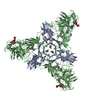
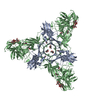

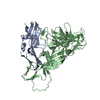
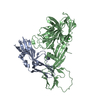
 PDBj
PDBj